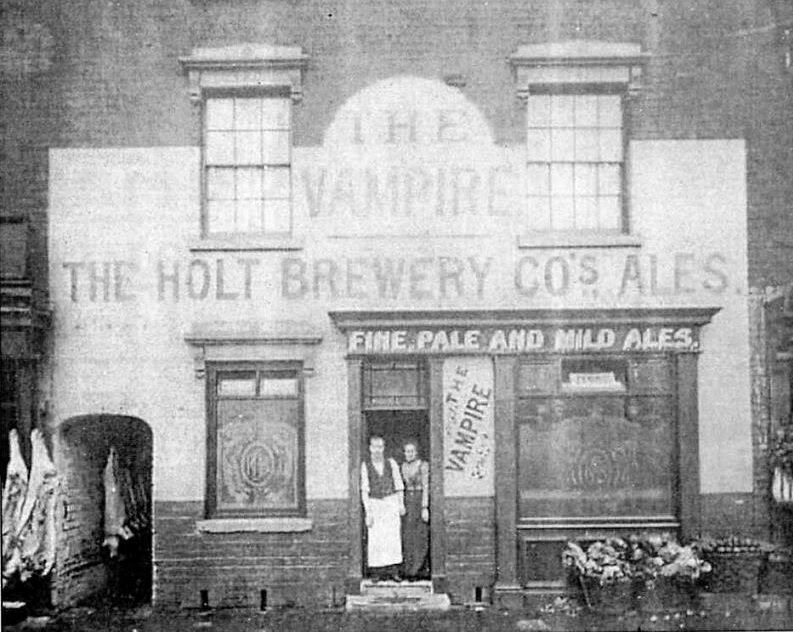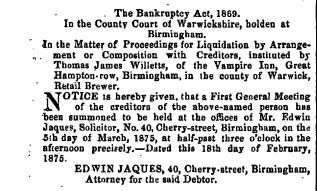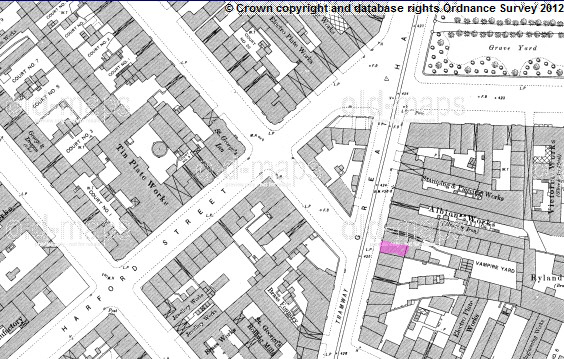Homemade Beer at the Vampire Inn May 13, 2014
Author: Beach Combing | in : Contemporary, Modern , trackbackEvery so often, as your eye is running down the columns of documents past, you run into an unlooked for detail that you just can’t leave alone. It happened to me a week ago when I was checking through the records of bankrupt British businesses from 1869 (as you do).
In that year on Hampton Row in central Birmingham (Britain’s second city) there is the record of a Vampire Inn. The earliest reference I can find, casting my net wider, is to 1861 when some baguatelle balls were stolen from one John Stagg there (landlord or renter?). In 1873 the landlord, George Jones, fell into the furnace of the brewery and survived. A later printed reference claims that the pub was finally demolished in the 1920s, though it may actually have lingered on till the 1950s (according to other online sources).
So much for the history of this institution but what about the name? English pubs are more usually called the Horse and Cart or the Royal Oak. How did a nineteenth-century inn get to be associated with a toothy supernatural entity? Western Europeans start expressing an interest in vampires in the eighteenth century. However, it is only in the nineteenth century that vampires really take off in the English imagination. In 1819 Polidori published The Vampyre (note spelling). Varney the Vampire: the Feast of Blood came out in serial form 1845-1847 and was immensely popular. Le Fanu published Carmilla in 1871, though this had little popular impact, while that mediocre stylist Bram Stoker changed history with Dracula in 1897 when the Vampire Inn had been serving its own beer for the best part of half a century.
Presumably, the Vampire Inn was named for Varney then? It is surprisingly difficult to get a good, complete online version of Varney but from the texts that I’ve seen Birmingham does not feature: Winchester seems to be the closest Varney came to the Midlands. But even if it did there is something strange about ‘Vampire Inn’: it just sounds wrong. If I’d read about a Vampire Inn in a modern historical novel on Victoria’s England I would have snorted with contempt and disbelief. I wonder if there might not be some other more innocent explanation, perhaps from mangled Brummie English that came to be understood as ‘Vampire’: Jim’s Pyre etc etc etc. This smacks of desperation but still… One excellent online forum has put up a map with a Vampire’s Yard behind. What came first the pub or the yard? Does Vampire even exist as a surname?
Any other thoughts on the origin of the Vampire Inn: drbeachcombing AT yahoo DOT com There is not place that Beach would rather have supped homemade beer in the nineteenth century.
16 May 2014: Jack writes with a theory that is poetry: ‘On the vampire inn, maybe because the pub was underneath the brewery and sucked the brew down through pipes, they were kinda like a vampire? just a thought.’ Thanks Jack, Varney did drink blood!
26 June 2014: AH writes in ‘Regarding your recent post, “Homemade Beer at the Vampire Inn”, I spotted something that may be of interest: “In that year on Hampton Row in central Birmingham (Britain’s second city) there is the record of a Vampire Inn. The earliest reference I can find, casting my net wider, is to 1861 when some baguatelle balls were stolen from one John Stagg there (landlord or renter?).” It might be a coincidence, but another John Stagg (1770-1823) is best known (to vampire fans, at least) for writing a poem entitled “The Vampyre”, which was published in his 1810 book, The Minstrel of the North: or, Cumbrian Legends. Being a Poetical Miscellany of Legendary, Gothic, and Romantic Tales.’ Thanks AH, a family member?





